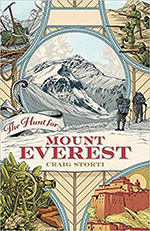Craig Storti’s ambitious book is a unique addition to the sagging shelves of literature on the world’s most famous mountain. Where most Everest books begin with the exploratory expedition to the peak in 1921, Storti’s story spans the seven or so decades before that pioneering venture.
Mountaineering lore holds that Radhanath Sickdhar (sic), a ‘computor’—as number-crunchers were known in those days—working for the Great Trigonometrical Survey of India, burst into the room of his boss one day in 1852 exclaiming: ‘Sir, I have discovered the highest mountain in the world.’ What was visible from Darjeeling as a mere smudge on the mountainous horizon was now ‘the third Pole’.
The survey of the Great Indian Arc, encompassing the subcontinent from its peninsular tip to its northern bastion, had reached the Himalayan foothills by 1850 making it possible for the first time to measure remote Himalayan peaks. As Nepal and Tibet were closed to foreigners at that time, theodolite readings of the ‘smudge’—called Peak XV at that time—were taken from six observation points near Darjeeling.

